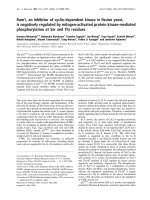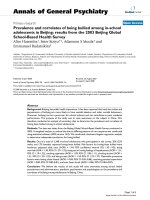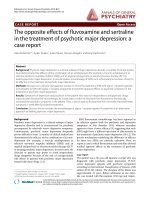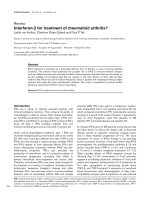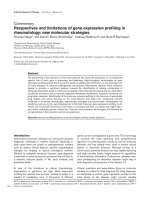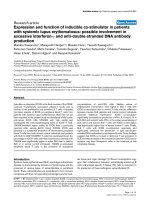Báo cáo y học: "Threshold for detection of diabetic peripheral sensory neuropathy using a range of research grade monofilaments in persons with Type 2 diabetes mellitu" pot
Bạn đang xem bản rút gọn của tài liệu. Xem và tải ngay bản đầy đủ của tài liệu tại đây (252.61 KB, 7 trang )
BioMed Central
Page 1 of 7
(page number not for citation purposes)
Journal of Foot and Ankle Research
Open Access
Research
Threshold for detection of diabetic peripheral sensory neuropathy
using a range of research grade monofilaments in persons with Type
2 diabetes mellitus
Mary P Thomson*
1
, Julia Potter
2
, Paul M Finch
3
and Richard B Paisey
4
Address:
1
Department of Podiatry and Foot Health, Torbay Hospital, Devon, UK,
2
School of Health Professions and Rehabilitation Sciences,
University of Southampton, Southampton, UK,
3
Chair of Health Sciences, Conestoga College, Ontario, Canada and
4
Diabetes Centre, Torbay
Hospital, Devon, UK
Email: Mary P Thomson* - ; Julia Potter - ; Paul M Finch - ;
Richard B Paisey -
* Corresponding author
Abstract
Aims: To identify the threshold of reduced sensory perception in Type 2 diabetes mellitus (Type
2 DM) using a range of research grade monofilaments.
Methods: Three groups of participants were recruited into a between subject, cross-sectional
study. Group 1(NEW), persons with Type 2 DM diagnosed for less than 2 years (n = 80); Group 2
(EST) persons with Type 2 DM diagnosed for more than 2 years (n = 91), and Group 3, a
Comparison group without Type 2 DM (n = 73), resulted in a total study population, n = 244.
Research grade monofilaments (2, 4, 6, 8 and 10-gram) were employed using standardised protocol,
at 6 sites on the plantar aspect of both feet. The demographic and anthropometric measures of
gender, age, height, weight, body mass index (BMI), blood pressure and duration of Type 2 DM
since diagnosis (if applicable) of the participants were analysed.
Results: Perception of the research grade monofilaments differed significantly between the 3
groups (p < 0.05). The 6-gram monofilament was found to be the threshold of normal perception,
based on 90% of the Comparison group perceiving the 6-gram monofilament at all sites in contrast
to 64% of NEW and 48% of EST groups.
Conclusion: The 6-gram monofilament was identified as the threshold of normal sensory
perception. Inability to perceive the 6-gram monofilament indicates, when using the method
described in this study, that diminution of sensory perception is evident. Employing a range of
monofilaments, 6, 8 and 10-grams in Type 2 DM foot screening would allow the clinical detection
of deteriorating sensory perception and enable implementation of foot protection strategies at an
earlier stage than is currently practised.
Background
One of the common long-term complications of diabetes
is neuropathy [1] of which there are several types with var-
ying clinical features. The clinical definition of diabetic
peripheral sensory neuropathy (DPSN) used in this study
is:
Published: 11 September 2008
Journal of Foot and Ankle Research 2008, 1:9 doi:10.1186/1757-1146-1-9
Received: 18 May 2008
Accepted: 11 September 2008
This article is available from: />© 2008 Thomson et al; licensee BioMed Central Ltd.
This is an Open Access article distributed under the terms of the Creative Commons Attribution License ( />),
which permits unrestricted use, distribution, and reproduction in any medium, provided the original work is properly cited.
Journal of Foot and Ankle Research 2008, 1:9 />Page 2 of 7
(page number not for citation purposes)
'a condition in which patients with diabetes experience
symptoms such as pain, burning, hyperaesthesia, or are
found to have signs of nerve damage of which they are una-
ware, principally the anaesthetic and deformed foot.' [2]
It should be noted, however, that a number of persons
with diabetes are aware of the signs of developing nerve
damage in their feet.
Prevalence of DPSN varies widely in studies, depending
on the criteria for diagnosis and the sensitivity of its detec-
tion [3]. A community-based study [4] found a prevalence
of 42% in persons diagnosed with Type 2 diabetes for
more than 2 years, of whom only 48% reported signifi-
cant neuropathic symptoms.
It has been recorded that 99% of diabetes care is self-care
[5], and it is part of the role of the health care professional
to enable people to improve their diabetes-related coping
skills, encouraging them to improve self-care behaviour,
metabolic outcomes and thereby quality of life. The use of
simple clinical tests allows a person with diabetes to
understand a developing complication, such as loss of
protective sensation in its early stages. This gives the
knowledge and therefore the option to those with early
Type 2 diabetes to make the behavioural changes that may
be required to prevent foot problems such as ulceration
and amputation.
The clinical design of this study was intended to produce
results that could be easily interpreted by both clinician
and layperson.
Whilst acknowledging that assessment of both vibration
perception threshold and 10-gram monofilament
together provide the most specific and most sensitive
method of assessing sensory status in the diabetic foot [6],
for the purpose of this paper the authors have concen-
trated on monofilament assessment alone [7-9].
The inability to perceive the 10-gram monofilament at
non-callused sites on the plantar aspect of the foot indi-
cates that there is a loss of protective sensation which
increases the risk of neuropathic foot ulceration [7,9,10].
One study [11] calculated that lack of perception of the
10-gram monofilament equated to a 10-fold increased
risk of ulceration. The employment of a range of monofil-
aments have been used since the development of the
Semmes-Weinstein monofilaments circa 1950 [12] and
there has been some disparity amongst researchers as to
the minimum weighted monofilament that qualifies as
the 'normal' threshold [13-15]. One study [16] concluded
that perception of a monofilament of approximately 2-
grams placed a person within the normal range whereas
another [6] used a 5-gram monofilament as the reference
for normal perception in the foot.
Therefore for this study a range of research grade monofil-
aments (2, 4, 6, 8 and 10-grams) applied to specific sites,
avoiding overlying callus, were employed in order to iden-
tify the threshold for normal perception, thus enabling
both clinician and person with diabetes to appreciate
diminished sensory perception prior to the 10-gram
threshold which indicates loss of sensory perception [7,9-
11]. Earlier recognition of developing neuropathy by both
person with diabetes and clinician allows discussion of
behaviour changes necessary to protect the feet. This
would include the introduction of daily inspection of feet
and discussion relating to the appropriateness and neces-
sity of having correctly fitting footwear, introduced to the
person with diabetes over a period of time, rather than at
a later stage when neuropathy is overt, when the clinician
might well insist on these behaviour changes immedi-
ately, which might meet with resistance from the person
with diabetes.
Three groups of participants were recruited; newly-diag-
nosed (less than 2 years since diagnosis); established
(more than 2 years since diagnosis) and a comparison
group without Type 2 diabetes mellitus or family history
of it. It is recognised that the newly-diagnosed group may
well have been developing Type 2 DM for some time prior
to official diagnosis as would have been the case for the
established group. However the intention was to investi-
gate two separate cohorts of persons with Type 2 DM in
order to enable comparison of those with Type 2 DM of
longer duration with those of shorter duration as will be
seen in the results section.
The sites tested by monofilament and number of applica-
tions at each site, vary widely in studies as may be seen in
Table 1[17].
The six sites selected for testing for this study were the
plantar aspect of hallux, first, second, third, fourth and
fifth metatarsal heads, avoiding callus [18] with loss of
perception to one site indicating loss of perception to that
weight of monofilament [7,9,19,20].
Investigating specific sites in the forefoot with a range of
monofilaments in order to ascertain when perception
deviates from the expected threshold would allow both
preventative therapeutic action and education to be initi-
ated at an earlier stage than is currently the norm. This
study was designed to identify the threshold at which it is
clinically feasible to detect reduced sensory perception in
Type 2 DM. Therefore the experimental hypothesis was:
there is a difference between three groups, new and estab-
lished Type 2 diabetic participants and a comparison
Journal of Foot and Ankle Research 2008, 1:9 />Page 3 of 7
(page number not for citation purposes)
group, and their perception of a range of research grade
monofilaments applied to six sites on the plantar aspect of
the foot.
Methods
Ethical approval was granted by Torbay Local Research
Ethics Committee. Information sheets were provided and
written consent obtained from each participant prior to
the commencement of the study. Persons with any condi-
tion (other than diabetes) associated with peripheral neu-
ropathy or impaired nerve responses, cancer therapy
(current or in the past five years), myocardial infarction,
angioplasty or bypass graft, rheumatoid arthritis, alcohol-
ism, history of or current ulceration, gross pedal deform-
ity, use of walking aid and pregnancy were excluded from
the study.
Three groups of participants were recruited for the study
by convenience sampling and all were Caucasian except
one South Asian. As indicated in Table 2, there was a
group of 80 persons with Type 2 DM diagnosed for less
than two years (NEW), and a group of 91 persons with
established Type 2 DM of more than 2 years since diagno-
sis (EST). Both groups with Type 2 DM were recruited
from G.P practices in the community and were recruited
as they became available providing they fulfilled the
inclusion and exclusion criteria. The third group of 73 par-
ticipants (Comparison) did not have Type 2 diabetes mel-
litus or any known family history of the disease, with
normal glucose tolerance on 75 gram oral glucose toler-
ance test, were recruited from friends and hospital staff.
The demographic and anthropometric measures of gen-
der, age, height, weight, body mass index (BMI), blood
Table 1: The number of sites tested with 10-gram monofilament in various studies.
Author (s) Number of Sites tested/recommended No. of sites insensitive to represent PN
Holewski, Stess et al (1988) 6 3/6
Kumar, Fernando et al (1991) 1 1
Rith-Najarian, Stolusky et al (1992) 8 1 but retested twice
McNeely, Boyko et al (1995) 9 1/9
Dorgan, Birke et al (1995) 5 Not stated
Litzelman, Marriott et al (1997) 3 1
Frykberg, Lavery et al (1998) 3 2/3
Boyko, Ahroni et al (1999) 9 1/9
International Working Group on the Diabetic Foot (1999) 3 2/3 retested twice
Pham, Armstrong et al (2000) 1 1
PN = peripheral neuropathy
Table 2: Participant demographics.
NEW n = 80 EST n = 91 Comparison n = 73 p value
Gender Male 44 66 38 = 0.013*
Female 36 25 35
Age Mean 59.6 61.4 52.6* <0.001*
+/- SD 8.4 8.4 10.6
Height Mean 170.7 171.4 172.6 = 0.45
+/- SD 9.1 8.7 9.5
Weight Mean 94.8 89.2 76.6* <0.001*
+/- SD 17 16 1.6
BMI Mean 32.7** 30.5** 25.5* <0.001*
+/- SD 6.1 5.5 3.4 = 0.016**
HbA
1
c Mean 8 8.3 5.6* <0.001*
+/- SD 1.4 1.6 0.5
Systolic Mean 141 136 129* <0.05*
+/- SD 17.2 18.3 17.2
Diastolic Mean 82.7** 76.9** 79.5 <0.001**
+/- SD 7.9 9.5 11.8
Duration Mean 12.5 106.3 N/A N/A
months +/- SD 7.4 78.2
Key: * denotes that the Comparison group was significantly different from diabetic groups
** denotes significant difference between 2 diabetic groups
N/A = not applicable
Journal of Foot and Ankle Research 2008, 1:9 />Page 4 of 7
(page number not for citation purposes)
pressure and duration of Type 2 DM since diagnosis (if
applicable) of the participants were recorded.
In order to test sensory perception, research grade mono-
filaments (Bailey Instruments, Manchester) 2, 4, 6, 8, and
10-gram were employed in accordance with the predeter-
mined protocol. This was informed by a pilot study [20],
and incorporated the approach suggested by Booth and
Young [21], in which each monofilament was 'bounced'
three times prior to the test and not used more than 100
times in a 24 hour period.
In this study, inability to perceive a monofilament at any
of the sites on the foot was recorded as loss of perception
to that weight of monofilament. The test was clearly
explained to the participant, and a monofilament was
demonstrated on the inside of the investigator's forearm
and then repeated at the same site on the participant. They
were asked to say 'yes' every time they perceived the
monofilament on their foot. Six sites were marked and
tested on each foot; the participant closed their eyes and
was therefore unable to see which site was being tested
[20]. The testing of each site with a single monofilament
took approximately 2 seconds, and the ascending method
of limits was employed, commencing with the 2-gram
monofilament. The six sites; pulp of hallux, 1
st
, 2
nd
, 3
rd
,
4
th
and 5
th
MTPJs on each foot were tested, once with each
monofilament, but the timing between each test was var-
ied. One investigator conducted all the monofilament
testing. Data from both feet of the participants were col-
lected and is available but right foot only data were ana-
lysed in detail, as in other studies [22]. Data were analysed
using SPSS Release 10 software. Comparison of gender
was tested by Chi-square and demographic, anthropomet-
ric and biochemical data between the three groups were
tested by one way analysis of variance (ANOVA). Mono-
filament data were deemed to be ordinal and statistical
analysis was performed using the Jonckheere-Terpstra (J-
T) test, a non-parametric test for several independent sam-
ples [23].
At completion of data collection all monofilaments were
retested by the manufacturer and they were found to
deform to their relevant weight.
The level of significance selected for the results was 0.05
for hypothesis testing.
Results
Data were collected from the 244 participants, see Table 2.
There was a significant difference between the three
groups for gender (p = 0.013). The Comparison group
were specifically recruited for this study (38 males, 35
females) whereas the other two groups were recruited by
convenience sampling. As expected the Comparison
group show lower blood pressure (systolic and diastolic),
lower body weight, BMI and HbA
1
c than the groups with
diabetes (ANOVA with Bonferroni multiple comparisons
p < 0.001). Interestingly the BMI, and diastolic blood
pressures are significantly greater in the NEW group com-
pared with the EST diabetes group (p = 0.016 and p <
0.001 respectively), suggesting that optimum control of
Type 2 DM in the NEW group had not yet been achieved.
The Comparison group was significantly younger than the
two diabetes groups, p < 0.001 (mean ages: NEW = 59.6;
EST = 61.4 and Comparison = 52.6), which was due to the
recruitment process.
The results of the monofilament testing for the three
groups at the six sites are presented in Figures 1, which
shows the percentage of sites perceived in each group with
each weight of monofilament on the right foot.
Figure 1 shows that only 19% of the NEW, 9% of the EST
and 52% of the Comparison group, could perceive all six
sites when the 2-gram monofilament was applied.
It can be seen that with the heavier 4-gram monofilament
more participants in all 3 groups perceived it at all 6 sites;
51% of the NEW, 33% of the EST and 81% of the Com-
parison participants.
The numbers of participants in each group able to per-
ceive the 6-gram monofilament at all sites increased
again: 64% NEW; 48% EST and 90% Comparison.
Figure 1
Figure 1. The percentage of participants in each group, who perceived the
monofilaments at all sites, at each weight.
0
10
20
30
40
50
60
70
80
90
100
246810
Monofilament Weight (Grams)
Percentage perception
New
Established
Comparison
Journal of Foot and Ankle Research 2008, 1:9 />Page 5 of 7
(page number not for citation purposes)
When the 8-gram monofilament was applied, 75% NEW,
66% EST and 99% of the Comparison group perceived all
six sites. And finally, 84% of NEW, 79% of EST and 100%
of the Comparison group perceived the 10-gram monofil-
ament at all sites.
The summary of monofilament perception at all sites and
the Jonckheere-Terpstra test (2 degrees of freedom) results
are shown in Table 3. This illustrates the results for the 6-
gram monofilament, that is, 64% NEW, 48% EST and
90% of the Comparison group perceived the 6-gram
monofilament at all sites, and puts them into the context
of results from other weighted monofilaments. Figure 1
interprets the results in Table 3 graphically and demon-
strates that the greatest difference between the 3 groups
occurred with the results of the 4 and 6-gram monofila-
ments.
In the context of the results presented above, the null
hypothesis was rejected as there were significant differ-
ences between the groups (p < 0.05).
Discussion
In this study a series of research grade monofilaments; 2,
4, 6, 8 and 10-gram, were used at six sites on the plantar
aspect of the foot to test sensory perception. The study
showed that only 52% of the Comparison group could
perceive the 2-gram monofilament at all sites, which sug-
gests that its routine use for screening for diminished sen-
sation is not appropriate. The results of the 4-gram
monofilament suggest that a clinical sensory threshold
was becoming apparent but only 81% of the Comparison
group in our study could perceive the 4-gram at all sites
and this percentage was considered too low to warrant rec-
ognition as the sensory threshold. However, two other
studies, a Japanese study [24] and an American study [25]
concluded that using the 4-gram and the 4.5-gram mono-
filament respectively, rather than the traditionally used
10-gram monofilament would be clinically useful for
detecting DPSN at an earlier stage. When the 6-gram
monofilament was employed in our study, the percentage
of persons able to perceive it at all sites rose to 90% of the
Comparison group, 64% of the NEW and 48% of the EST
group. The 8-gram monofilament was perceived at all sites
by 99% of the Comparison group and 75% of the NEW
and 66% of EST respectively. These data indicate that
while less than 100% of the Comparison group were able
to perceive the 6-gram monofilament, it nevertheless
showed a greater differential between the sensory capabil-
ity of non-diabetic and diabetic participants than at 8-
grams or 10-grams. The Comparison group were younger
than the participants in the other two groups and this
might have affected the results. In addition, the findings
indicate that the group with diabetes of longer duration
(EST) was less able to perceive the 6-gram monofilament
than the group of participants with newly-diagnosed dia-
betes (NEW), reinforcing the notion that sensation dimin-
ishes as the duration of diabetes increases. It could be
argued that 95% is most commonly used to indicate nor-
mality but this figure is probably achieved between 6 and
8-grams (unknown as a 7-gram monofilament was not
used) after careful consideration the authors decided to
use 90% as the level to indicate normality and therefore
perception of the 6-gram monofilament as the threshold.
Clinical judgement is required when interpreting results
and false positives may be recorded when using the 6-
gram monofilament, it should be clearly appreciated that
loss of perception to the 6-gram monofilament is not
diagnostic of DPSN. However, the main thrust of this
study is to heighten the awareness of diminishing sensa-
tion prior to outright loss of protective sensation at 10-
grams in order to empower the person with Type 2 diabe-
tes to take ownership of their condition and enable them
to take action in order to prevent problems developing in
their feet.
The results suggest that using a range of monofilaments
(6, 8 and 10-gram) provides the ability to detect dimin-
ished sensation at an earlier stage than use of the 10-gram
monofilament alone. Persons with diabetes frequently do
not regard DPSN as a problem unless it causes discomfort,
and large discrepancies exist between foot care knowl-
edge, perceived vulnerability and behaviour [26]. It might
be anticipated that the use of a range of monofilaments
could clearly demonstrate the need for increased vigilance
with foot care to the person with diabetes. The employ-
ment of a range of monofilaments would allow protection
and prevention programs for foot care to be introduced at
an earlier stage as required by the National Service Frame-
work for Diabetes [27].
Table 3: The percentage of participants in each group, who perceived the monofilaments at all sites.
Monofilament NEW n = 80 EST n = 91 Comparison n = 73 p value
2-gram 19% 9% 52% <0.001
4-gram 51% 33% 81% <0.001
6-gram 64% 48% 90% = 0.003
8-gram 75% 66% 99% < 0.001
10-gram 84% 79% 100% = 0.004
Journal of Foot and Ankle Research 2008, 1:9 />Page 6 of 7
(page number not for citation purposes)
The monofilaments used in this study are estimated, by
the manufacturer Bailey Instruments, Manchester, using
unpublished archive data on file (1998), to be able to
endure approximately 24000 'bounces' before they lose
their integrity (that is equivalent to 2000 patients using
the testing protocol used in the study). Currently, the cost
of an individual monofilament manufactured by Bailey
Instruments Manchester is £14 plus VAT, therefore setting
the cost of a series of monofilaments (6-gram, 8-gram and
10-gram) of £42 plus VAT against the mean weekly cost of
£59 for a non-infected foot ulcer [28,29] clearly demon-
strating the potential cost-effectiveness of a range of
monofilaments.
The results of this study are based on the criteria of testing
6 sites and application of each monofilament once at each
of those sites. Other workers have used different criteria;
such as testing a different number of sites, from 1 site [7],
3 sites [11,19] to 9 sites [9] and applying the monofila-
ment 3 times at each site and recording the majority
response [11,30]. Another criterion in this study deter-
mined that the selected monofilament had to be per-
ceived at all 6 sites whereas other studies used different
criteria such as 3 sites perceived out of 6 [18]. Thus it may
be seen that it is difficult to compare studies when differ-
ent criteria are used. This problem could be resolved by
the use of electrophysiological studies which are consid-
ered to be the gold standard for assessing and confirming
neuropathy as the tests are sensitive, reliable and repro-
ducible. However, the tests are limited as they are time-
consuming, can be uncomfortable for the patients, and
need skilled personnel to interpret the results [31]. The
current study reveals that more research is required into
the use of monofilaments. Future research should include
the development of a standardised protocol incorporating
the method of application to include selection and iden-
tification of the precise sites to be tested, number of appli-
cations at a particular site with each monofilament, the
order of the sites tested by the individual monofilaments,
and translation of results.
Conclusion
Most (90%) healthy persons without Type 2 DM were
able to perceive the 6-gram monofilament at the selected
sites on the plantar aspect of the foot. It is therefore rea-
sonable to use the 6-gram monofilament as a threshold
measure for screening persons with Type 2 DM. Inability
to perceive the 6-gram monofilament indicates, when
using the method described in this study, that diminution
of sensory perception is evident. The 8-gram monofila-
ment should be employed if perception is not apparent at
all sites and finally the 10-gram monofilament. This
method would allow stepwise progression of education
for the person with Type 2 DM at annual review.
Abbreviations
ANOVA: analysis of variance; DM: diabetes mellitus;
DPSN: diabetic peripheral sensory neuropathy; EST: par-
ticipants diagnosed with Type 2 diabetes for more than 2
years; MTPJ: metatarso-phalangeal joint; NEW: partici-
pants diagnosed with Type 2 diabetes for less than 2 years.
Competing interests
The authors declare that they have no competing interests.
Authors' contributions
MT conceived and designed the study, undertook all data
collection and analysis and wrote the paper. JP supervised
the study at all levels from the design stages, interpreta-
tion of data through to completion of the paper to which
she has given permission for publication. PF has been
involved in intellectual discussions with regard to the
study throughout, revising the manuscript for important
intellectual content and has given approval for the final
version to be published. RP has actively participated and
supported the conception and design of the study, super-
vising all the recruitment of the participants actively dis-
cussed the interpretation and implications of results and
proof read the final paper and given approval for the final
version to be published.
Acknowledgements
The statistical support for this study was provided by Mrs S High of the
Department of Social Statistics, University of Southampton.
References
1. Boulton AJM, Malik RA, Arezzo JC, Sosenko JM: Diabetic Somatic
Neuropathies. Diabetes Care 2004, 27:1458-1487.
2. Ward J: New concepts in diabetic neuropathy. Part 1. The
condition and its measurement. In The Essential Facts Scotia
Pharmaceuticals Ltd; 1997.
3. Franklin GM, Kahn LB, Baxter J, Marshall JA, Hamman RF: Sensory
neuropathy in non-insulin-dependent diabetes mellitus. The
San Luis Valley Diabetes Study. Am J Epidemio 1990,
131:633-643.
4. Kumar S, Ashe HA, Parnell LN, Fernando DJ, Tsigos C, Young R: The
prevalence of foot ulceration and its correlates in type 2 dia-
betic patients: A population-based study. Diabet Med 1994,
11:480-484.
5. Rubin RR: Psychotherapy and Counselling in Diabetes Melli-
tus. In Psychology in Diabetes Care Edited by: Snoek FJ, Skinner TC.
Chichester: John Wiley & Sons Ltd; 2000:235-263.
6. McGill M, Molyneaux L, Spencer R, Heng LF, Yue DK: Possible
Sources of Discrepancies in the Use of the Semmes-Wein-
stein Monofilament. Diabetes Care 1999, 22:598-602.
7. Kumar S, Fernando DJ, Veves A, Knowles EA, Young MJ, Boulton AJ:
Semmes-Weinstein monofilaments: a simple, effective and
inexpensive screening device for identifying diabetic patients
at risk of foot ulceration. Diabetes Res Clin Pract 1991, 13:63-67.
8. Pham H, Armstrong DG, Harvey C, Harkless LB, Giurini JM, Veves A:
Screening techniques to identify people at high risk for dia-
betic foot ulceration: A prospective multicenter trial. Diabe-
tes Care 2000, 23:606-611.
9. Boyko EJ, Ahroni JH, Stensel V, Forsberg RC, Davignon DR, Smith
DG: A prospective study of risk factors for diabetic foot ulcer.
The Seattle Diabetic Foot Study. Diabetes Care 1999,
22:1036-1042.
10. National Collaborating Centre for Primary Care: Clinical Guideline
10: Type 2 diabetes: Prevention and management of foot
problems. National Institute for Clinical Excellence, London; 2004.
Publish with BioMed Central and every
scientist can read your work free of charge
"BioMed Central will be the most significant development for
disseminating the results of biomedical research in our lifetime."
Sir Paul Nurse, Cancer Research UK
Your research papers will be:
available free of charge to the entire biomedical community
peer reviewed and published immediately upon acceptance
cited in PubMed and archived on PubMed Central
yours — you keep the copyright
Submit your manuscript here:
/>BioMedcentral
Journal of Foot and Ankle Research 2008, 1:9 />Page 7 of 7
(page number not for citation purposes)
11. Frykberg RG, Lavery LA, Pham H, Harvey C, Harkless L, Veves A:
Role of neuropathy and high foot pressures in diabetic foot
ulceration. Diabetes Care 1998, 21:1714-1719.
12. Weinstein S: Fifty years of somatosensory research: from the
Semmes-Weinstein monofilaments to the Weinstein
Enhanced Sensory Test. J Hand Ther 1993, 6:11-22.
13. Bell-Krotoski J, Weinstein S, Weinstein C: Testing sensibility,
including touch-pressure, two-point discrimination, point
localization, and vibration. J Hand Ther 1993, 6:114-123.
14. Pfeifer MA, Tanenberg RJ, Holbert D, Schymer MP, Lee L, May K: The
Feasibility of using Monofilaments in Clinical Trials for Dia-
betic Neuropathy. Diabetes 2000, 49:166.
15. Jeng C, Michelson J, Mizel M: Sensory thresholds of normal
human feet. Foot Ankle Int 2000, 21:501-504.
16. Sosenko JM, Kato M, Soto R, Bild DE: Comparison of quantitative
sensory-threshold measures for their association with foot
ulceration in diabetic patients. Diabetes Care 1990,
13:1057-1061.
17. Thomson MP: The association of plantar pressure measure-
ments and perception of research grade monofilaments in
the feet of human participants with Type 2 diabetes mellitus.
In PhD thesis University of Southampton, School of Health Professions
and Rehabilitation Sciences; 2006.
18. Holewski JJ, Stess RM, Graf PM, Grunfeld C: Aesthesiometry:
quantification of cutaneous pressure sensation in diabetic
peripheral neuropathy. J Rehabil Res Dev 1988, 25:1-10.
19. Litzelman DK, Marriott DJ, Vinicor F: Independent Physiological
Predictors of Foot Lesions in Patients with NIDDM. Diabetes
Care 1997, 20:1273-1278.
20. Thomson MP, Paisey RP, Frost J, Potter J, Taylor P, Bower L: Sensory
testing of feet in subjects without diabetes mellitus as a base-
line for neuropathy studies. British Journal of Podiatry 2001,
4:49-52.
21. Booth J, Young MJ: Differences in the performance of commer-
cially available 10-g monofilaments. Diabetes Care 2000,
23(7):984-988.
22. Sosenko JM, Sparling YH, Dongsheng H, Welty T, Howard BV, Lee E,
Robbins DC: Use of the Semmes-Weinstein Monofilament in
the Strong Heart Study. Diabetes Care 1999, 22:1715-1721.
23. Portney LG, Watkins MP: Foundations of Clinical Research. Applications
to Practice 2nd edition. New Jersey: Prentice Hall Health; 2000.
24. Nagai Y, Sugiyama Y, Abe T, Nomura G: The 4-g Monofilament is
Clinically Useful for Detecting Diabetic Peripheral Neuropa-
thy. Diabetes Care 2001, 24:183-184.
25. Saltzman CL, Rashid R, Hayes A, Fellner C, Fitzpatrick D, Klapach A,
Frantz R, Hillis SL: 4.5-Gram monofilament sensation beneath
both first metatarsal heads indicates protective foot sensa-
tion in diabetic patients. J Bone Joint Surg Am 2004, 86-
A(4):717-723.
26. Caddick SL, Ibrahim S, Ward JD: The Management of Diabetic
Neuropathy. In Diabetic Neuropathy Edited by: Boulton AJM. Chich-
ester: Marius Press; 1997:147-157.
27. Diabetes NSF Team: National Service framework for Diabetes London,
Department of Health; 2001.
28. Netten A, Curts L: Unit Costs of Health and Social Care. Per-
sonal Social Services Research Unit, University of Kent, Can-
terbury 2001. The healthcare costs of diabetic peripheral neuropathy in
the UK. Diabetic Foot 2003, 6:62-73.
29. British Medical Association and Royal Pharmaceutical Society of
Great Britain, London: British National Formulary 43, March
2002. The healthcare costs of diabetic peripheral neuropathy in the UK.
Diabetic Foot 2003:62-73.
30. The International Working Group on the Diabetic Foot: International
Consensus on the Diabetic Foot Amsterdam; 1999.
31. Daube JR: Electrophysiologic Testing in Diabetic Neuropathy.
In Diabetic Neuropathy Edited by: Dyck PJ, Thomas PK. Philadelphia W
B Saunders Company; 1999:222-238.


